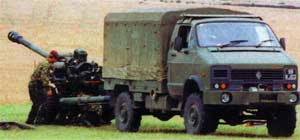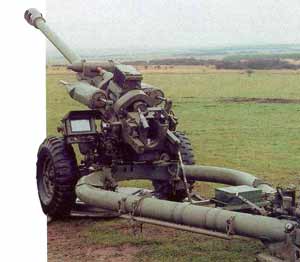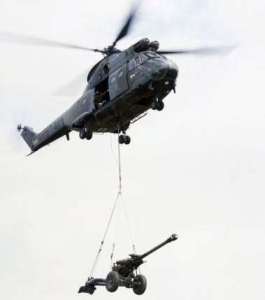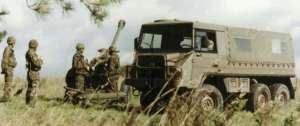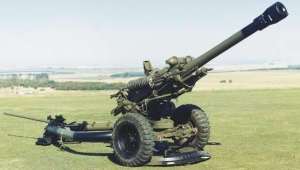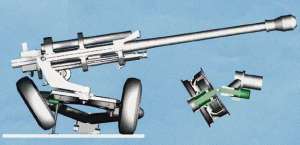| Designation: | L118 |
 |
|---|---|---|
| Manufacturer: | BAE SYSTEMS RO Defence | |
| Product type: | Weapons & Weapon Systems | |
| Name: | Towed gun |
In 1965, the British Army issued a requirement for a new 105 mm Light Gun to replace the Italian Oto Melara 105 mm Pack Howitzer then in use with the light regiments of the Royal Artillery.
The requirement was for a gun with a longer range, a more stable firing platform, improved reliability and the ability to be towed across rough terrain at high speed. Design work began at the Royal Armament Research and Development Establishment at Fort Halstead the following year.
Trials with the prototypes were successful and in 1973 the 105 mm Light Gun (L118) was accepted for service with the British Army. First production guns were handed over at now BAE Systems Land Systems, Nottingham in October 1974. Following closure of the Nottingham facility, production of the 105 mm Light Gun is being undertaken elsewhere.
The 105 mm Light Gun, which uses the same range of 105 mm ammunition as the Abbot self-propelled gun, replaced all 105 mm Pack Howitzers in regular units of the Royal Artillery and has been issued to TA units. Each 105 mm Light Gun Regiment has three batteries, each with eight guns.
Royal Artillery 105 mm Light Gun regiments earmarked for use with the Royal Marines and airborne forces have three batteries each of six guns.
Late in 1981, Australia selected the 105 mm Light Gun, where it is known as the Hamel Gun, to meet its future requirements.
In early 1986, following an extensive series of trials and demonstrations, the Light Gun was type-classified by the US Army as the M119. The Light Gun version involved is the L119 with a barrel suitable for firing US 105 mm M1 ammunition. The type classification followed the evaluation of six Light Guns leased to the US Army in late 1984, followed in mid-1985 by a further 14 guns. These were evaluated by the 9th Infantry Division at Fort Lewis, Washington, as the XM119.
The US Army is the largest user of the 105 mm Light Gun having taken delivery of 147 direct from Nottingham with another 280 manufactured under licence in the USA by Watervliet Arsenal (ordnance) and Rock Island Arsenal (carriage). Licensed production of the original 105 mm Light Gun has been completed in the US. Production of the more recent L119A2 has now started.
In mid-1991, the Brazilian Army placed an order for four 105 mm Light Guns in the L118 configuration. These were delivered early in 1992.
In December 1994, Brazil placed an order for a further 36 105 mm L118 Light Guns and the first of these were delivered early in 1995. This was followed by an order for 18 L118 Light Guns for the Brazilian Marines.
Early in 1995, the Royal Netherlands Marine Corps received eight 105 mm Light Guns from the United Arab Emirates.
In July 1995, the Spanish Cabinet approved the purchase of 56 105 mm L118 Light Guns for use by the Spanish Army Rapid Deployment Forces (FAR).
These 105 mm Light Guns are used by three battalions each consisting of three batteries, each with six guns. The remaining two were for the artillery school.
Total value of the contract, which covered the supply of the guns, spares and ammunition was estimated to be Pta8,850 million (USD48 million) over a five-year period ending in 1999.
EXPAL and General Dynamics Santa Barbara Sistemas were involved in the production of 105 mm ammunition in Spain. In addition, the contract included 38 kits to convert the L118 to the L119 standard to allow standard 105 mm HE M1 ammunition to be fired for training purposes.
The first batch of L118 105 mm Light Guns, together with a quantity of ammunition, spare parts and kits to convert the weapons to the L119 configuration for training purposes, were shipped in January 1996.
By early 2008, over 1,100 105 mm Light Guns had been built, including those produced under licence in Australia and the US.
Late in 1996, following an extensive series of user trials between the French Nexter Systems 105 mm LG1 Mk II Light Gun and the UK's 105 mm Light Gun, the latter was selected to meet the requirements of the Portuguese Army.
The contract for 21 105 mm L119 Light Guns was signed late in December 1997 and the first batch of eight guns was shipped in February 1998.
Portugal selected the 105 mm L119 gun which fires standard 105 mm HE M1 semi-fixed high-explosive ammunition. The Portuguese order included a 100 per cent offset.
In 2004 it was confirmed that Thailand had placed a contract with BAE Systems Land Systems covering an initial batch of 22 105 mm Light Guns.
The initial batch of weapons was for the Royal Thai Army but in the future it is expected that additional weapons will be procured for the Royal Thai Marine Corps, with the total requirement for both users between 60 and 80 weapons in the long term.
Thailand selected the L119 version, which uses the standard US 105 mm M1 HE projectile with a maximum range of 11.2 km as this is already used by other 105 mm weapons currently in service.
The first batch of 105 mm L119 Light Guns were delivered to Thailand late in 2005. Additional orders are expected to be placed in the future.
The Thai 105 mm L119 weapons are fitted with the now Selex Sensors and Airborne Systems Laser Inertial Pointing System (LINAPS), which is standard on all British Army 105 mm Light Guns. This will reduce into-action time, provide enhanced survivability against counterbattery fire and provide greater accuracy.
Production of the 105 mm Light Gun was originally undertaken at BAE Systems Land Systems facility at Nottingham that closed several years ago.
The company had to find new suppliers for almost every part of the weapon and these have now been qualified during an extensive series of firing and towing trials with two L119 weapons in the UK.
The 105 mm ordnance was supplied by the BAE Systems Land Systems facility at Barrow-in-Furness, while HSW of Poland supplied a number of elements including fabrications, trail and cradle. The saddle was provided by Paul Fabrications of the UK.
The 105 mm Light Gun consists of the following main components: elevating mass, saddle and controls, trail and spades, platform, suspension and sighting system.
The elevating mass consists of the 105 mm ordnance, recoil system, cradle including trunnions, balancing gear and electric firing gear. The gun is fitted with a multibaffle muzzle brake, which can be easily removed for cleaning. The vertical sliding breech block is actuated by a lever mounted on the top. The hydropneumatic recoil system has a separate recuperator and the buffer is fitted with a cut-off gear to shorten the recoil length as elevation is increased. The recoil system is mounted in a lightweight fabricated cradle, which carries the elevating arc and a simple helical compression spring-balancing gear. The firing gear, which is mounted on the cradle, is fully waterproofed and is of the electric magneto type, specially designed for use with the Cap Conducting Composition primer of the 105 mm Abbot ammunition system.
The saddle is a lightweight fabrication on which the complete elevating mass is carried. It provides a top traverse of 11°. The elevating gear is a simple mechanical system providing constant handwheel effort throughout the range of elevation. A clutch is provided to reduce abnormal firing loads on the equipment.
The trail is fabricated in high-strength corrosion-resistant steel. It is bow shaped, enabling the breech operator and loader to remain within the trail and maintain a high rate of fire at all elevations. The platform is carried on top of the trail during travelling. The forward end carries the saddle, traversing gear, suspension and the layer's seat. At the rear are the non-rotating towing eye, overrun brake, barrel clamp and spades. The spade system, of which there are three types, caters for various firing and ground conditions. The first type is a combined rock and digger spade for use, normally with the platform, on rock or firm ground; the second is a field spade for use on very soft ground or when firing without a platform and the third is a snow spade.
The platform is a circular lightweight fabrication that gives a firm base and permanent gun stability under all conditions. The tyres run on the outer edge of the platform, which is connected to the underside of the gun by four wire stays.
The wheels, which have large section 9.00 × 16 tyres, incorporate special hydraulically operated overrun brakes. This ensures safe towing at a high speed with a light vehicle such as a Land Rover (4 × 4). The brakes can also be operated during firing by a lever at the rear end of the trail. For manhandling purposes, an individual handbrake is fitted at each wheel. The trailing arm suspension has laminated torsion springs and shock-absorbers. The suspension system remains in operation during firing and assists in maintaining the stability of the equipment and reducing carriage stresses.
Indirect and direct sight system and controls are operated by the layer while seated. Indirect laying has been simplified by the abolition of a separate setting for angle of sight. The quadrant elevation is set on the elevation scale. A direct fire telescope is fitted which incorporates a moving illuminated graticule, which is adjusted for lead to allow for target movement and range. A direct fire night sight is also available. Trilux activated light sources are fitted to illuminate all scales and graticules, eliminating the use of electric batteries on the equipment.
The L35 charge contains the first five charge zones in a single brass cartridge case. The propellant charge is ignited by the L10 electrical primer, which is more reliable than a percussion primer. The Supercharge, L36, for maximum range, has a separate brass case and also has an L10 electrical primer. Polycarbonate spoiler rings can be clipped onto the nose of the projectile enabling targets to be engaged between 2,400 m and 3,600 m; these reduce the range by causing aerodynamic drag.
In mid-1986, it was revealed that the now BAE Systems Land Systems was working on extended-range (base bleed) and cargo rounds as a private venture. The former has been fired with standard Supercharge L36 and has achieved a range of over 20,000 m compared to the 17,200 m of the standard projectile. The base bleed round is currently designated the X/RO 0381 ERHE which during trials in 1998 achieved a range of around 20.60 km. This extended-range projectile has yet to enter production.
The 105 mm Light Gun fires the following BAE Systems Land Systems-manufactured separate loading ammunition: HE (L31) with the projectile weighing 16.1 kg; HESH (L42) with the projectile weighing 10.49 kg (no longer produced); illuminating (L43); SH/practice (L41- no longer produced); smoke (L45) with the projectile weighing 15.89 kg; smoke, coloured red (L37) and smoke, coloured orange (L38).
A range of 14,300 m can be achieved by the L119 Light Gun firing the M760, which is basically an M1 projectille with an M200 charge system. A range of 19,500 m can be achieved with the M913 HERA projectile and 19,000 m with the new ERM1 base bleed projectile.
The 105 mm Light Gun can be carried slung under a Puma helicopter as one load. The elevating mass can be removed to give two light helicopter (for example, Wessex) loads and the complete weapon can be reassembled with one simple tool in less than 30 minutes.
The 105 mm Light Gun is normally towed with the gun in the forward (firing) position. For long distances the gun is towed with the barrel rotated through 180° and clamped to the trail. This attitude is achieved by jacking up the equipment with a jack stowed on the trail, removing the quick-release wheel and traverse gear pin, clamping the barrel and replacing the wheel. The complete conversion takes less than 1 minute.
Firing US M1 105 mm ammunition and using the M200 charge system originally developed for the M204, a range of 14,000 m is achieved. Firing the M913 HERA cartridge, with the M229 charge 8 propelling charge, a range of 19,500 m is achieved. US changes include: modifications to the sight to permit use of the deflection method of laying, revision of the graticule pattern of the sight to incorporate 5 mil graduations instead of 10 mil, addition of attachment brackets for the battery computer, provision of attachment brackets for M90 muzzle velocity measurement system, labelling of all items containing radioactive elements (tritium sights), modification of tie down brackets, use of standard US paint type and US camouflage pattern, use of nitrogen in the recoil system instead of air, use of US tail-light patterns, incorporation of recent UK MoD minor modifications, elevation level guidance plate for M200 charge system, modified engraving and limited US thread forms in some areas of the weapon.
To meet the requirements of the Swiss Army the L127A1 Light Gun was developed by BAE Systems Land Systems, with the ordnance being designated the L27A1. This is very similar to the British Army version but can fire Swiss ammunition. There were two guns delivered to Switzerland in 1979-80 with a further four following in 1981, but no production order was placed.
In British Army service the 105 mm Light Gun was expected to have been replaced by the Light Mobile Artillery Weapon System (LIMAWS).
There are two parts to LIMAWS, LIMAWS (Gun) and LIMAWS (Rocket). The aim of LIMAWS is to provide an indirect fire capability to support light and rapid effect forces.
The UK Defence Procurement Agency in 2001 awarded a contract to the now BAE Systems Land Systems to manage the Assessment Phase for enhanced ammunition for the 105 mm Light Gun used by the Royal Artillery.
In 2005 following an international competition, the UK Defence Procurement Agency (DPA) awarded BAE Systems Land Systems a contract to supply a new generation of High-Explosive (HE) ammunition for the 105 mm L118 Light Gun used by the Royal Artillery.
Under the terms of the contract, awarded by the DPA's Future Artillery Weapons Systems (FAWS) Integrated Product Team (IPT), an initial batch of 105 mm HE ammunition were supplied for qualification.
The new Improved Ammunition (IA) for the 105 mm L118 Light Gun is of the Insensitive Munition (IM) type and replace the in-service 105 mm L31 HE projectile, which has a maximum range of 17.2 km.
The new 105 mm HE IM round will also have improved lethality, at least 20 per cent, and will be the first IM artillery round to enter service with the UK. It will be ballistic match to the in-service L31 HE round.
Production of the new IA 105 mm ammunition will be undertaken at the BAE Systems Land Systems main ammunition production facility at Glascoed in South Wales.
In recent years the company has invested some GBP15 million in this new IM facility at Gloscoed, which is now the ammunition HQ of BAE Systems Land Systems.
BAE Systems Land Systems has also developed, in association with German company Buck Neue Technologien, a new 105 mm smoke projectile with a red phosphorous payload. This offers bi-spectral screening in the vision and infra-red spectra.
BAE Systems Land Systems has developed an upgrade package for the L118 and L119 Light Gun which can be incorporated into new production weapons or retrofitted to existing weapons.
The main improvements can be summarised as:
- Currently one of the wheels has to be removed when rotating the gun to its stowed position. This is time consuming and adds to the burden of the gun crew. Instead of removing the wheel slide it partly out of the axle and let it hinge down. When the gun is rotated simply lift the wheel, slide it back into position and lock it in place
- The current platform must be handled by the crew when bringing the weapon into action. The platform is relatively heavy and weight saving would reduce crew fatigue and improve overall gun performance. A new platform has been constructed from aluminium and thus weight is significantly reduced
- The maintenance burden of the existing recoil system is relatively high and a maintenance free recoil system has been introduced with fewer parts and modern sealing technology
- When hosing the gun down with high-pressure hose jets water can ingress into the gearbox. A thicker cover plate has been introduced with a modern sealing capacity
- Under some circumstances there is difficulty in attaching the 105 mm Light Gun to the towing vehicle and there is limited crew assistance for a large traverse movement. Handgrips have been introduced to the gun trails to assist the user
- The existing brake system is maintenance intensive and the handbrake lever can be difficult to operate. An updated brake system is introduced for easier user operation
- The existing 'A' frame under the forward part of the weapon can become distorted and has difficult to engage locking pins. Into and out of action times are slower due to pin engagement difficulties. The existing A frame is replaced with a single strut and centre traverse lock
- The clearance between the gun and towing vehicle can cause user problems with towing and manoeuvring. A new extended towing eye is introduced.
Early in 1999, following an international competition, the UK MoD selected the now Selex Sensors and Airborne Systems Laser Inertial Pointing System (LINAPS).
The contract, valued at over GBP10 million, was for the supply of 137 APS, or Laser Inertial Automatic Pointing Systems (LINAPS) as it is called by the company, for installation on the BAE Systems Land Systems 105 mm L118 Light Guns used by the Royal Artillery.
First production LINAPS were delivered late in 1999 and deliveries ran to the year 2002. The contract also covers logistic support for an inertial period of five years.
The LINAPS consists of the proven FIN3110L integrated Inertial/Global Positioning System (GPS), a large screen Layers Display and Control Unit (LDCU), a wheel hub mounted odometer and a Power Management System (PMS). In addition there is a Navigation Display Unit (NDU) for use in the cab of the Pinzgauer Turbo D 4 × 4 gun-towing vehicle.
The mounting of the INS/GPS directly above the barrel permits the direct measurement of all elevation and azimuth and hence the rapid and accurate pointing of the gun onto the target. In addition, LINAPS provides the precise location of the 105 mm gun platform with a route navigation capability.
It provides the crew with orientation and location data without the requirement for much of the existing sighting and survey equipment and its associated training.
The installation of the APS on the BAE Systems Land Systems 105 mm Light Gun L118 has made for a much-reduced into-action time as well as greater accuracy. LINAPS is also installed on the Royal Thai Army 105 mm L119 Light Guns and on the Canadian 155 mm M777.
For many years the British Army used the 25 pounder as its standard saluting gun. These have now been replaced by a modified 105 mm Light Gun.
This work was carried out by ABRO. The guns were stripped of their components and all paint was chemically removed. All components were given a thorough safety check and the firing mechanism was altered to allow only blanks to be fired.
Finally the weapon was reassembled and specially painted, although some parts were chromed in order to improve its appearance.
|
||||||||||||||||||||||||||||
|
|||||||||
Related Articles |
|
BAE Systems wins competition for 105 mm improved ammunition (18.03.2005) |




















